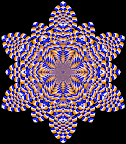Five-month-old Samuel doesn't seem at all worried about the large plaster covering his right eye. He gurgles contentedly and tugs inquisitively at the white curtain in front of his nose, until it is lifted up by an invisible force. Now Samuel is looking at a chessboard which is drawn in such a way that it seems to be receding into the distance away from him.
From this background two bright orange hippos are staring at him; Samuel looks back at them with interest. He tries to grab hold of the hippo which is located a little lower down than the left-hand hippo; it squeaks and the curtain falls. When it goes up a few seconds later, two pelicans have taken over from the hippos. This time the left-hand pelican is lower down. Samuel reaches out for the bright red beak, there is a squeak and the curtain falls. After two dozen repetitions a voice in the background says, 'Thank you, that'll be all,' thereby ending Samuel's guest appearance at the University of Bonn's Institute of Psychology.Baby Samuel taking part in the perception test. (Photo courtesy of University Of Bonn) You can see the checkerboard like pattern with the orange hippos on it.
'What we are investigating here is at what point babies can begin to decipher visual data about perspective,' says Laura Hemker, who is doing her PhD at the Institute. The problem is that even the brightest baby cannot yet say, at the age of five months, what it can see. For this reason the researchers on Dr. Michael Kavšek's team had to think up a trick enabling them to detect the perceptive faculties of their little guinea pigs. 'If you offer a baby two toys, it usually goes for the nearest one,' Laura Hemker explains. 'We make use of this fact for our experiment.' The PhD student put 20 seven-month-old babies and 20 five-month-old babies in front of the chessboard background. Due to the perspective figures which are fixed higher up and near the horizon appear further away than rubber toys which are a little lower down – although this is only the case if the observer covers over one eye. Otherwise the stereoscopic data provided by a pair of eyes cancel out the effect of perspective faked by the chessboard. 'This is precisely what we observe with our babies,' adds Julia Niehl, one of the students assisting in the project. 'If they can use both eyes they choose one of the two toys at random. However, when we cover over one eye, they more often go for the toy located lower down which appears closer because of the data on perspective contained in the background image.'
At any rate, 19 of the 20 seven-month-old babies went for the lower one rather than the higher one significantly more frequently when they could only use one eye. In eight out of ten cases they first tried to touch the toy that seemed nearer. However, if they were allowed to use both eyes, the location of the toys had no effect on the toys selected.
Even in the case of the five-month-old babies it was 16 out of 20 who reacted to data on perspective – which came as a surprise to the psychologists, as previously most experts had assumed that babies did not acquire this ability until about the age of seven months – 'and that this took place, so to speak, from one day to the next, almost as if someone had flicked a switch,' says Dr. Kavšek, who heads this study on perception. 'Our findings, however, seem to point to a continuous process of development: babies become aware of depth-of-field data at a very early age; the older they are, the less obvious the signals need to be and the better it works.'
Probably the perception of perspective kicks in even earlier. However, to test this hypothesis the psychologists would have to change the way their experiment is set up: most babies cannot reach out for something specific until they are four or five months old.
This story has been adapted from a news release issued by University Of Bonn.
Description Presented here is a vast gallery of many different forms of Optical Illusions. Whether these optical illusions are conveyed through fractals, photographs, architecture, art, or old fashioned pen and ink, they are bound to remind you that "seeing is not believing."
Caution!!!! Some of the optical illusions on this blog may cause dizziness or possibly epileptic seizures. The latter happens when the brain can't handle the conflicting information from your two eyes. If you start feeling unwell when using this website, immediately cover one eye with your hand and then leave the page. Do not close your eyes because that can make the attack worse.
Caution!!!! Some of the optical illusions on this blog may cause dizziness or possibly epileptic seizures. The latter happens when the brain can't handle the conflicting information from your two eyes. If you start feeling unwell when using this website, immediately cover one eye with your hand and then leave the page. Do not close your eyes because that can make the attack worse.
Wednesday
Even babies can have optical illusions
Subscribe to:
Post Comments (Atom)
Copyright Notice
The documents distributed here have been presented on this blog in the spirit of providing an entertaining venue to educate those interested in optical illusions.
All Flckr.com photos are presented here via Flckr's "blog this" feature. This feature is enabled by each artist on Flckr. If you find material here that belongs to you and you would like to have it removed or credited please contact me and I will gladly follow your wishes.
Copyright and all rights therein are maintained by the authors or by other copyright holders. It is understood that all persons copying this information will adhere to the terms and constraints invoked by each author's copyright. These works may not be reposted without the explicit permission of the copyright holder.









0 comments:
Post a Comment | Random Illusion